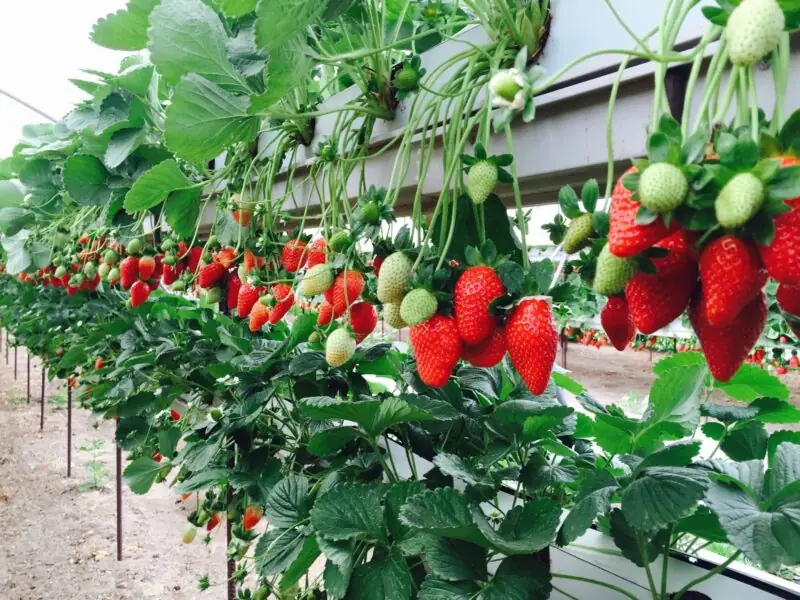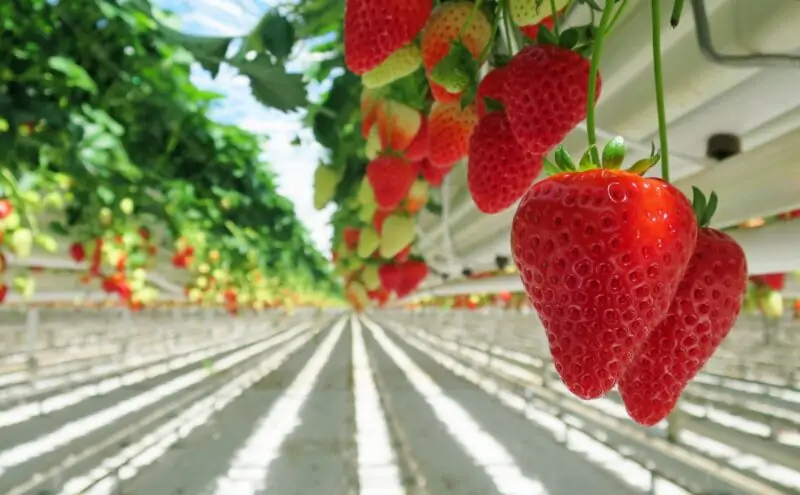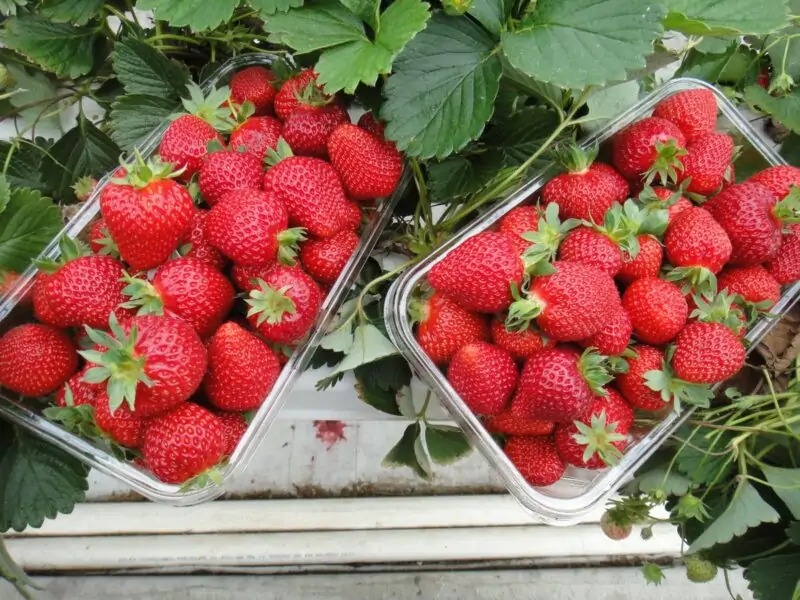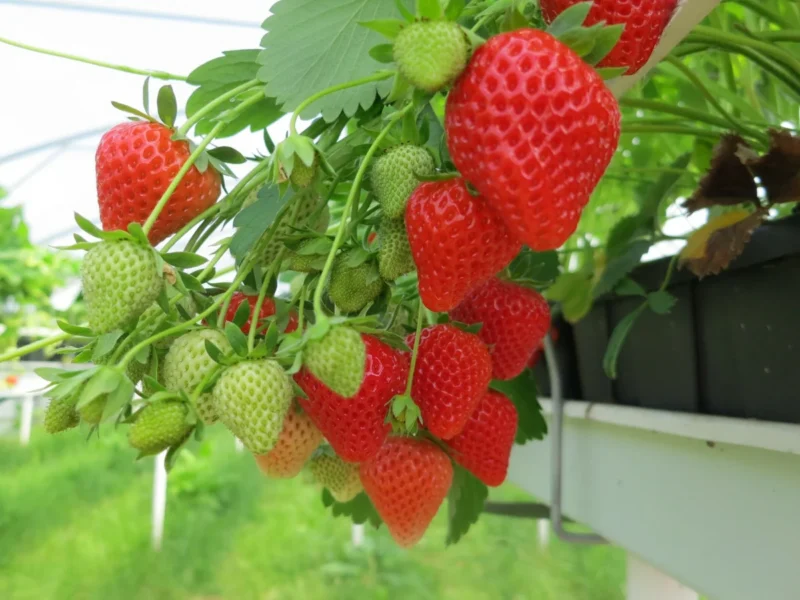What Are Hydroponic Strawberries? Safe to Eat Berry Delights Grown Without Soil

Getting to Know Hydroponic Strawberries
What are hydroponic strawberries? Do you adore strawberries but face limitations in terms of space for a conventional garden? Alternatively, are you looking to grow fresh, organic strawberries much more efficiently instead of traditional systems where crops are grown outdoors? Look no further; indoor growing with a hydroponic setup may be just what you’ve been looking for!
The Essence of Strawberries Grown in Hydroponic Setups

Hydroponics involves growing plants without traditional soil systems. Instead, they’re grown in water, where a nutrient-rich mixture serves as the primary medium. In the case of growing strawberries hydroponically, growers use a variety of substrates. These include perlite and coco coir. This is used to anchor the roots while supplying oxygen and eliminates the need for potting soil.
You can set up the growing system indoors or outdoors. This allows you to control every aspect of your plant’s environment. The method leads to quicker growth, higher yields, fresher fruit with fewer pesticides, and less water usage.
The Role of Hydroponics in Strawberry Cultivation
Strawberry plants need specific conditions. These aren’t always available when growing strawberries in soil. They need the right pH levels, between 5.5-6.5. They require drain systems to prevent root rot from over-watering. They also need sufficient aeration to minimize fungal diseases.
Hydroponics is an excellent solution. It gives growers total control over these factors. It also allows them to adjust irrigation timing and amounts. If you’ve opted to grow healthy berries, expect a good harvest throughout the year, no matter the weather.
Moreover, it cuts labor costs. There’s no need for tilling the land, which saves time and energy each planting season. The same can’t be said for strawberries grown in soil.
Why Grow Hydroponic Strawberries? The Main Appeal
Now that we understand what hydroponic strawberries are let’s explore why hydroponic plants are becoming popular, along with the advantages and disadvantages:
Benefits of Growing Hydroponically
The most significant advantage is its yield potential. This is due to careful plant nutrition management, which leads to larger and more abundant fruits.
Hydroponically grown strawberries mature faster. This results in shorter crop cycles. Growers can harvest their berries up to three times a year. This contrasts with the once-a-year harvest of traditional methods. Since you can grow any time of the year, you also have more freedom in terms of choice.
Additionally, there are fewer pest issues. This is good for farmers who want to grow clean produce without harmful chemicals. Traditional insecticides or pesticides can be toxic to both humans and wildlife.
In short, whatever you’re growing, expect good fruit, and more of it.
Drawbacks of Hydroponic Strawberries
Like any farming method, there are some drawbacks to consider:
The first is cost. Strawberries that are grown this way deliver higher yields over time. However, setting up a hydroponic system requires specialized equipment and knowledge. These add to the costs.
The second is taste. Some consumers report that hydroponic strawberries typically don’t taste quite the same as soil-grown strawberries.
Lastly, it takes a significant amount of energy. This is needed by climate-control equipment throughout the growing cycle. If powered solely by non-renewable sources, it could cause environmental degradation. Plus, it’s not a reliable way to grow if you don’t have access to a reliable power source. Solar power may also be used, but it too requires an initial investment.
Are Hydroponic Strawberries Organic?
Whether or not hydroponic strawberries are organic depends on one’s definition of organic.
Clarifying the Organic Nature of Hydroponically Grown Berries
Hydroponically grown berries can be “organic,” but only if they meet strict guidelines. These are set by the USDA’s National Organic Program (NOP). For instance, the NOP bans synthetic fertilizers, pesticides, and herbicides. All inputs must come from organically certified companies approved by global governing bodies.
The challenge here limits growers’ choices. It also requires them to monitor nutrient levels to avoid over-reliance on certain brands.
Pesticides and Fertilizers in Hydroponic Gardens
One of the main benefits of hydroponics is almost no need for insecticides. However, strawberries need fertilizers or pesticides.
Hydroponic strawberry cultivation relies on nutrient solutions mixed with water. These provide the plants with the nutrients they require.
However, some people may see these strawberries as organic. Others may believe that only produce grown from soil can be considered organic. The validity of organic hydroponic strawberries is ultimately a matter of opinion.
What Are Hydroponically Grown Strawberries?

Growing hydroponic strawberries can be an exciting venture. If you decide to get a hydroponic system, you must understand a few crucial aspects. Hydroponic growing differs from traditional soil-based gardening but isn’t excessively complex.
Essential Steps for Your Own Hydroponic Strawberry Garden
The first move in growing hydroponic strawberries is choosing the right location and gear. A space with controlled lighting and temperature is essential. Easy access to water and electricity is also crucial.
After setting up a suitable location, it’s time to pick your hydroponic system. There are many types available, such as deep-water culture (DWC), ebb-and-flow systems, and nutrient film technique (NFT) systems. Each system has its pros and cons.
Once your system is set up correctly, it’s time to add quality nutrients. These nutrients cater to your plant’s needs throughout its lifecycle. A pH testing kit can be a beneficial purchase as well.
Techniques for Planting Hydroponic Strawberries
Planting strawberry seeds or seedlings in a soil-less environment requires care. Make sure they’re anchored securely. This allows the roots to spread out properly without interfering with water flow.
Beforehand, germinate strawberry seeds into plugs using rockwool cubes. Soak the cubes overnight and drain off excess moisture. Keep the humidity high until sprouts emerge, which usually takes about ten days.
These young plants initially need about twelve hours of light per day. Gradually increase this duration over several weeks. A maximum of 18-20 hours of light daily will stimulate growth once the plants are established.
Clean, uncontaminated substrates like sterile peat moss mixed with something like perlite works best. You can also use coco coir mixed with vermiculite.
Light, Temperature, and Water Quality
Strawberries need optimal lighting conditions. At least 8 hours of light per day is recommended, but up to 18-20 hours can promote faster growth. LEDs are efficient for this purpose.
Strawberries prefer temperatures between 65°F -80°F (18°C-27 °C) during the day and cooler nights. Temperature control is crucial when growing hydroponic strawberries. Without proper regulation, high humidity levels can cause wilting leaves and root rot.
Water quality also impacts plant health. Ensure the water temperature stays within the desired range to avoid harming your strawberry crop.
Choosing the Right Growing Medium for Hydroponic Strawberries
Hydroponics relies heavily on selecting appropriate substrates. Options include inert materials like pebbles and rockwool cubes, coconut fiber-coco coir mixes, and expanded clay pellets.
In contrast, soil-based gardening limits substrate choices. Synthetic blends that retain moisture are an option, but may not be feasible if you’re looking for organic produce.
Choosing an ideal growing medium depends on factors like location, climate, and personal preferences. Research is key before deciding what will work best for you.
Nutrient Solution and Fertilizer Use in Hydroponics
In hydroponics, nutrients are added directly to the roots, unlike in traditional gardens, where nutrients come mainly from soil breakdown over time. Therefore, choosing the right nutrient solution is key, as different growth stages require specific solutions. A balanced mix containing all essential elements and micronutrients is best for optimal nutrition.
The Process of Pollination in Hydroponic Gardens
Pollination can occur naturally through bees, but manual methods are also needed when growing hydroponic strawberries. Use a cotton Q-tip or oft-bristled brush to transfer pollen from one flower to another. This process must be done every few days until the strawberries are mature and ready to harvest.
Pruning and Propagation of Hydroponic Strawberries
Pruning helps direct energy from leaves into roots and stems. This enhances the overall plant vigor and focuses on producing larger fruits. Removing runners that divert nutrients can also aid in future production.
Propagation involves taking cuttings or clones, which are rooted and placed in net pots filled with an appropriate substrate. These are then transplanted after rooting is accomplished. These are used for growing copies of your favorite plant.
Common Growing Problems and Their Solutions
Water and nutrients are just a small part of the equation. Anything that messes with the ebb and flow of the growth process is bad. Like any farming method, hydroponic strawberries may face problems that affect plant growth and yield. That’s why it’s important to know what can go wrong and how you can fix it.

Nutrient Imbalance
Nutrient imbalance is a common problem for hydroponic growers. This happens when the essential mineral levels are too high or too low. These include nitrogen (N), phosphorus (P), potassium (K), calcium (Ca), and magnesium (Mg). These imbalances can stunt growth or reduce the quality of your strawberries.
To correct this problem:
- Check pH levels regularly. Ensure they are between 5 and 6.
- Use nutritional supplements specific to each growth stage.
- During vegetative stages, use high N supplements.
- In early flowering, use a higher concentration of P & K.
- For later flowering, use more Ca & Mg.
Environmental Factors Affecting Growth
The environment plays a big role in healthy plant development. The conditions in an indoor or outdoor growing space can vary greatly. Here’s what you need to know:
Too Much Light
Strawberries need 10-12 hours of light per day. Too much light can lead to photobleaching. This reduces chlorophyll production and can cause the leaves to yellow or brown.
To treat this issue:
- Reduce the number of lights in your grow area.
- Use shades or covers during peak sunlight periods.
Temperature Fluctuations
Inconsistent temperature levels can create an unfavorable growing environment. This can slow growth, leading to slightly fewer berries and poor fruit quality.
To fix this problem:
- Use temperature control systems like air conditioning or heating for indoor spaces.
- Make sure there’s proper ventilation, especially indoors.
Pest and Disease Control Measures
Hydroponic growers must watch out for pests such as spider mites and aphids. Diseases like grey mold, powdery mildew, and leaf spot fungus can also be problematic. These are often spread by spores in humid conditions.
Here are some tips to keep pests out of your hydroponic garden:
- Inspect new plants before adding them to your system.
- Use integrated pest management techniques. Try to use biological controls over chemical pesticides.
- Keep everything clean. Regularly clean all equipment used in the garden space.
Hydroponics and Strawberries FAQs
Yes! Hydroponics supports seed germination just like soil-based farming. These are the first things you need to grow if starting from scratch. Seeds should first be sterilized using fungicides. They can then be placed into a medium like rockwool cubes. From there, they can be transplanted when stable.
Hydroponic strawberries are grown without soil. This gives the grower more control over the nutrients and minerals in their system. It also impacts fruit quality. Hydroponics can produce higher yields because plants get what they need when they need it.
Yes! Organic certification can be achieved with accredited third-party certifiers. They evaluate each operation based on location, practices, and growing inputs. Hydroculture methods meet all the requirements necessary for organic certification.
Conclusion
So, what are hydroponic strawberries? They’re delicious berry treats grown using a soil-less cultivation method, substituting traditional materials with a nutrient-rich water mixture. Hydroponic strawberries can be grown in places where normal farming is not feasible. Don’t let fears of potential issues like nutrient imbalances or pest infestations deter you from hydroponic strawberry production. With proper attention and care throughout your system’s growth cycle, these common problems can easily be solved.
We hope this article answered any questions you had about troubleshooting issues encountered while growing strawberries in a soilless farming approach. Happy Growing!